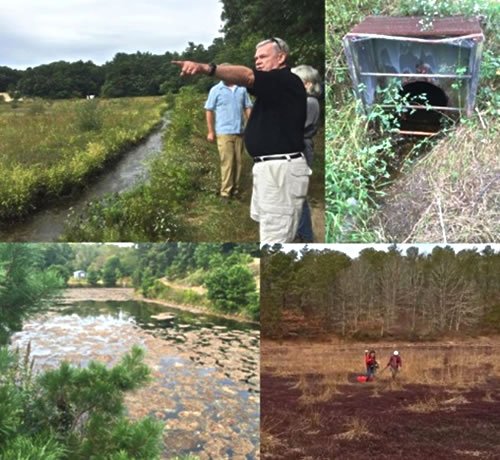Small Sponsor, Big Results: Local Club Takes on Childs River Restoration
February 2020
Falmouth Rod & Gun Club—a 75-year-old club with a maximum of 300 members—is spearheading an impressive effort to restore and enhance the upper Childs River. Prior industrial and agricultural use has polluted and choked off the river's flow. A dam now separates the river's upper reaches from Waquoit Bay and a failed fish ladder prevents migratory passage. Both will be removed when the club begins construction to restore habitat, the aim for which is full rehabilitation of the river to a cold- water fishery.
Brook trout, American eel, and river herring are expected to return to the Childs River, but these swimmers won't be the only ones to benefit from the coming changes. Visitors will be able to hike, hunt, and view the Farley and Garner Bog areas along the river via footpaths converted from dirt roads, and the club is planning walking tours of the restoration site. Based on the success of nearby restorations like Tidmarsh Farm and the Coonamasset River, the group anticipates that the improved water flow will also alleviate flooding concerns for communities in the watershed and raise the water quality in estuaries downstream.

This restoration follows the club's successful work rehabilitating the lower part of the Childs. Both projects were inspired by concern for the watershed and the wildlife that call it home, and club members agreed a restoration was far preferable to shouldering the liability for maintaining the infrastructure on club property. For this project, the club has managed a team of collaborators, funders, contractors, and permitting agencies. They have secured leases, titles, and conservation restrictions to adjacent parcels, including to the Farley Cranberry Bog, which has grown over with upland species and will be converted to a wetland. The full scope of work includes removal of a dam and a culvert replacement, digging a modified stream channel, and removing the remnants of cranberry farming activities like water control structures, several feet of sand, and ditches. Woody material and native plants will help populate the newly exposed peat soil. The club is also prepared with a monitoring plan to measure the project's impact.
SNEP began funding this work in 2018, when the club was beginning the process of closing on property acquisitions and laying out initial designs. Some materials have already been delivered and monitoring has begun. Permitting is ongoing and the club expects to put construction contracts out to bid soon.
Pending final funding, the project will break ground this spring or summer.
Project leader Gary Anderson ([email protected] or by phone 508-540-1283).
